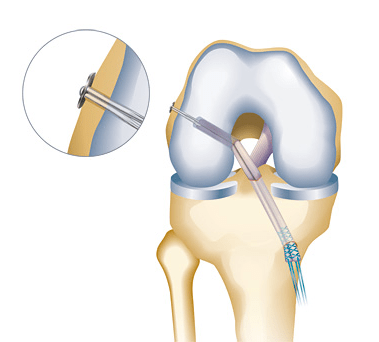Knee Conditions
ACL Reconstruction
The anterior cruciate ligament is one of the major stabilizing ligaments in the knee. It is a strong rope- like structure located in the center of the knee running from the femur to the tibia. When this ligament tears, unfortunately, it doesn’t heal and often leads to the feeling of instability in the knee.

ACL reconstruction is a commonly performed surgical procedure and with recent advances in arthroscopic surgery, can now be performed with minimal incisions and low complication rates.
The ACL is the major stabilizing ligament in the knee. It prevents the tibia (shin bone) moving abnormally on the femur (thigh bone). When this abnormal movement occurs, it is referred to as instability and the patient is aware of this abnormal movement.
Often, other structures such as the meniscus, the articular cartilage (lining the joint) or other ligaments can also be damaged at the same time as a cruciate injury and these may need to be addressed at the time of surgery.
- Most injuries are sports-related involving a twisting injury to the knee.
- It can occur with a sudden change of direction, a direct blow, e.g., a tackle, landing awkwardly.
- Often there is a popping sound when the ligament ruptures.
- Swelling usually occurs within hours.
- There is often the feeling of the knee popping out of joint.
- It is rare to be able to continue playing sport with the initial injury.
Once the initial injury settles down, the main symptom is instability or giving way of the knee. This usually occurs with running activities, but can occur with simple walking or other activities of daily living. The diagnosis can often be made on the history alone.
Examination reveals instability of the knee, if adequately relaxed or not too painful. An MRI (Magnetic Resonance Imaging) can be helpful if there is a doubt, or to look for damage to other structures within the knee. At times the final diagnosis can only be made under an anesthetic or with an arthroscopy.
What are the treatment options?
Initial
- Rest
- Ice
- Elevation
- Bandage
Long term
Not everyone needs surgery. Some people can compensate for the injured ligament with strengthening exercises or a brace. It is strongly advised to give up sports involving twisting activities, if you have an ACL injury.
- Episodes of instability can cause further damage to important structures within the knee that may result in early arthritis
What are the indications for surgery?
Young patients wishing to maintain an active lifestyle.
Sports involving twisting activities, e.g., soccer, netball, football Giving way with activities of daily living.
People with dangerous occupations, e.g., policemen, firemen, roofers, scaffolders.
It is advisable to have physiotherapy prior to surgery to regain motion and strengthen the muscles as much as possible.
How is surgery performed?
Surgical techniques have improved significantly over the last decade, complications are reduced and recovery much quicker than in the past.
The surgery is performed arthroscopically. The ruptured ligament is removed and then tunnels (holes) in the bone are drilled to accept the new graft. This graft which replaces your old ACL is taken either from the hamstring tendon or the patella tendon. There are advantages & disadvantages of each, with the final decision based on the surgeon’s preference.
The graft is prepared to take the form of a new tendon and passed through the drill holes in the bone.
The new tendon is then fixed into the bone with various devices to hold it in place, while the ligament heals into the bone (usually 6 months).
The rest of the knee can be clearly visualized at the same time and any other damage is dealt with, e.g., meniscal tears.
The wounds are then closed, often with a drain, and a dressing applied.

